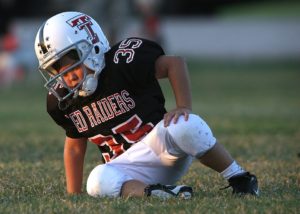 Is football causing CTE? The full name of CTE is chronic traumatic encephalopathy, which is a degenerative brain condition that is found in athletes, military combat veterans, and other individuals who have received repeated blows or trauma to the head. Through a process that is still being explored, repeated blows to the head, such as those caused by the abrupt jarring of the brain from collisions in football, result in the buildup of tau in the brain. tau is a plaque-like buildup that spreads within the brain and kills neurons. As neurons in the brain die, the person experiences changes in mood, cognitive functioning, and personality.
Is football causing CTE? The full name of CTE is chronic traumatic encephalopathy, which is a degenerative brain condition that is found in athletes, military combat veterans, and other individuals who have received repeated blows or trauma to the head. Through a process that is still being explored, repeated blows to the head, such as those caused by the abrupt jarring of the brain from collisions in football, result in the buildup of tau in the brain. tau is a plaque-like buildup that spreads within the brain and kills neurons. As neurons in the brain die, the person experiences changes in mood, cognitive functioning, and personality.
Symptoms of CTE
The above description of CTE sounds pretty scary, right? As tau causes the deaths of neurons, what are the symptoms? Since our brains regulate all areas of functioning, CTE can result in negative changes in a number of areas. These changes might include:
- Increased aggression
- Moodiness
- Memory loss
- Confusion
- Erratic behavior
- Personality changes
- Paranoia
- Anger outbursts
- Declines in cognitive functioning
The Evidence of Football Causing CTE
I’ve blogged about the dangers of football before. I’ve grown up in Texas, and we’re definitely a hotbed of football. I grew up a Houston Oilers fan (that’s right, the Oilers, not the Texans…I date myself!). Then, as a graduate of The University of Texas at Austin, I’ve been a fan of my beloved Longhorns since undergrad. But I must admit, as much as I still like football and want to watch games, I’m feeling increasingly conflicted. The evidence is mounting that the repeated collisions caused in football lead to CTE.
Now, it very difficult to definitively prove that the repeated blows to the head and jarring of the brain in football cause CTE. After all, one can’t take a large group of young twin boys and randomly assign one to playing football and one to playing tennis, let them play each sport for 20 years, and then compare their brains. Moreover, CTE can’t be diagnosed with certainty unless an autopsy is conducted. But a recent study in which the brains of deceased former NFL players were examined, 110 of 111 were diagnosed with CTE. Another study found that playing tackle football before the age of 12 was associated with brain problems later on in life.
Football Players With CTE
Some famous football players who have been diagnosed with CTE upon their death, some of whom died of suicide, include:
- Mike Webster (Pittsburgh Steelers)
- Kenny Stabler (Oakland Raiders)
- Junior Seau (San Diego Chargers)
- Frank Gifford (New York Giants)
- Andre Waters (Philadelphia Eagles)
Sadly, former Longhorn football player and lineman for the Atlanta Falcons, Shane Dronett, committed suicide in 2009 at the age of 38. An autopsy confirmed that he had CTE. I remember when I found out that this happened and was deeply affected by the news. I had watched him play when he was at UT. Unfortunately, his story was not covered in the sports section of our local paper, The Austin-American Statesman. I even emailed the head sports writer and asked to tell Mr. Dronett’s story, but I never saw a word. I guess the negative coverage of football and connecting it to CTE would conflict with the celebration of all things football within the newspaper. Folks don’t want to feel guilty about being football fans – me included. But the more time that passes and the more science that comes out about CTE, the more conflicted that I feel.
Big Tobacco, Big Oil, and the NFL
For decades, the tobacco industry denied the link between cigarette smoking and cancer. But they knew. Similarly, oil companies deny or sow the seeds of doubt, often through the use of “dark money,” on the overwhelming data that our use of fossil fuels leads to climate change. Like Big Tobacco, the NFL seems to be denying (or in denial?) of the data that the long-term consequences of the repeated collisions in football can lead to CTE. Perhaps the NFL is waiting for definitive “proof” that, in the long-term, football can cause CTE. Given that it is a multi-billion dollar business, they have a vested interest in refuting or debating the scientific findings as long as they possibly can.
Importantly, there will always be exceptions that one can point out. For example, with smoking, some might say, “Well, my grandpa smoked all his life and lived to be 92 and HE never got cancer.” Well, that is what’s called “anecdotal evidence.” That’s not science. Sure, some people who smoke never get cancer. However, when we compare a large group of smokers to non-smokers, the cancer rate of smokers is considerably higher than that of nonsmokers for many types of cancers. For example, 85-90% of lung cancer deaths are attributable to smoking. We can always cherry-pick evidence to support a belief (which is a form of confirmation bias). But that’s not science.
Factors Related to the Development of CTE
When it comes to playing football, some people who play for many years will never experience CTE. However, the odds that one gets CTE from football increase based upon factors such as:
- The age one starts playing contact football
- How long contact football is played
- How many jarring hits/tackles one experiences (e.g., a placekicker vs. a lineman)
- Genetic variables
Importantly, no one seems to acquire CTE without repeated blows to the head. Tennis players and golfers don’t experience the symptoms of CTE and commit suicide.
The Irony of High School and College Football
I don’t think my next point is really debatable. Kids go to high school and college to learn. They are there to gain an education – to acquire knowledge and skills that allow them to grow as people. Ultimately, they use this education to find a gratifying career and contribute positively to society. If anything, high school and college should enrich minds, NOT damage them.
Powerhouse colleges recruit star high school athletes to play football. Now, this isn’t the case ALL the time, but often the courses that these star athletes take are very different from those of the regular class body. Great efforts are made on the part of the universities to ensure that these students can play on Saturday. That’s why we rarely hear that star college football players are “academically ineligible” to play. They are pampered through their coursework and, oftentimes, don’t acquire the level of education that will enable them to have marketable skills upon graduation. Instead, they sacrifice both mind and body for the glory of their university…and the money that it brings those universities. Ironically, high schools and colleges support a sport that damages the very minds that they are supposed to enrich.
The Takeaway?
Is football causing CTE? While more data need to be gathered, it is pretty clear that the long-term consequences of football aren’t good for the body and brain. Our brains are the most complicated thing in the universe (as far as we know). The repeated collisions and jarring of the brain that are intrinsic to football cause damage. Over time and for many players, this can result in CTE.
It’s not just the concussions, which are brain damage in and of themselves. The numerous sub-concussive impacts are what linked to the development of CTE. But football is a multi-billionaire industry. And we enjoy watching and playing it. Whether we want to admit it or not, we are all psychologically motivated to be dismissive of the research that football is causing CTE. It makes us uncomfortable to accept these facts. It causes a level of cognitive dissonance that we want to resolve. So, we tend to ignore this research and continue to watch.
I don’t know what it would take for things to change. Honestly, I’d miss football if it disappeared. But I won’t allow my three sons to play it because I know what the science says. So, why should I be accepting of other parents’ sons damaging their brains? Am I complicit? As difficult as I find it to do, I can’t ignore the science and my own internal conflict. Change should always start with ourselves, so that’s what I am going to do.

I truly appreciate your honesty about this brain injury and information to support it.